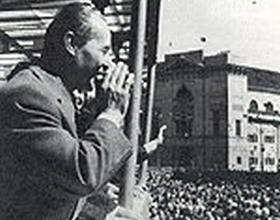


Werner Herzogs poetik 5

Jeg må gøre Herzog-genfortællingen færdig. (Før jeg i morgen er på Cinéma du réel festivalen i Paris. I fjendens lejr.) Tue Steen Müller bragte det forleden frem til til Minnesota-erklæringens punkt 5, om de dybere lag i filmkunsten.
5. Herzog slår fast at de findes der i den filmiske konstruktion. I modsætning til den journalistiske reportage, hvor de ville forstyrre. Men det må ikke få os til at det samme gælder film, hvor der findes sådan noget som poetisk og henreven sandhed. Den er mystisk og flygtig og kan kun nås ved digtning, fantasi og stilisering.
6. Cinémá verité folk ligner turister som tager billeder midt iblandt kendsgerningers ældgamle ruiner, erklærer han bekymret. Jeg tror han tænker på om hans egne reportager slår til, om de mange fluen på væggen film nu virkelig tænkes færdige. Jo, ok, mestrenes gør, Dvortsevoys gør. Franks, men Wisemans? Altid? Bang Carlsens? Wivels? Aldrig turismens lethed? Jo, da, som vi andre. Dog, Leth digter, fantaserer og stiliserer hele tiden.
7. Men tordner den evigt kontinent-vandrende Herzog: turisme er synd, fodrejse er dyd!
8. Og så fortæller han en historie om de snesevis på snescootere som i det smeltende forår braser igennem isen på søerne i Minnesota. Presset på guvernøren er stort for at få ham til at lovgive om det. Men denne forhenværende bryder og bodyguard har svaret: man kan ikke lave love imod dumhed.
9. Så er handsken kastet, noterer Herzog. Dette er modstanderen. Og det bliver hovedtema i speaken til Grizzly Man, naiviteten over for naturens virkelighed set gennem mange erkendelseslag i et filmværk.
10. For månen er mat, moder natur kalder ikke, taler ikke til dig, lige meget hvor meget gletscheren giver lyd fra sig. Og lad være med at lytte til livets sang. Bedrøvede råd til Amie Huguenard og Timothy Threadwell, som forførte af et naivt natursyn leverede den ultimative reportage.
11. Så vi skal være taknemmelige for, at universet derude ikke kender noget smil.
12. Werner Herzog konkluderer sin erklæring og filmkunstneriske program: Livet i oceanerne må være et rent helvede. Et umådeligt, nådeløst helvede af permanent og direkte fare. Så meget helvede, at nogle arter, herunder mennesket, under evolutionen kravlede og flød op på nogle små stykker fastland, hvor mørkets lære fortsætter.







